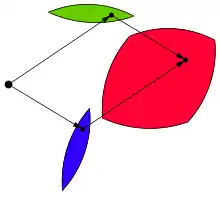Minkowski addition
In geometry, the Minkowski sum (also known as dilation) of two sets of position vectors A and B in Euclidean space is formed by adding each vector in A to each vector in B, i.e., the set

Analogously, the Minkowski difference (or geometric difference)[1] is defined using the complement operation as
In general . For instance, in a one-dimensional case and the Minkowski difference , whereas
In a two-dimensional case, Minkowski difference is closely related to erosion (morphology) in image processing.



The concept is named for Hermann Minkowski.
Example
For example, if we have two sets A and B, each consisting of three position vectors (informally, three points), representing the vertices of two triangles in , with coordinates
and
then their Minkowski sum is
which comprises the vertices of a hexagon.
For Minkowski addition, the zero set, {0}, containing only the zero vector, 0, is an identity element: for every subset S of a vector space,
The empty set is important in Minkowski addition, because the empty set annihilates every other subset: for every subset S of a vector space, its sum with the empty set is empty:


Convex hulls of Minkowski sums
Minkowski addition behaves well with respect to the operation of taking convex hulls, as shown by the following proposition:
- For all non-empty subsets S1 and S2 of a real vector space, the convex hull of their Minkowski sum is the Minkowski sum of their convex hulls:
This result holds more generally for any finite collection of non-empty sets:
In mathematical terminology, the operations of Minkowski summation and of forming convex hulls are commuting operations.[2][3]
If S is a convex set then is also a convex set; furthermore
for every . Conversely, if this "distributive property" holds for all non-negative real numbers, , then the set is convex.[4]
The figure shows an example of a non-convex set for which A + A ⊋ 2A.

An example in 1 dimension is: B=[1,2]∪[4,5]. It can be easily calculated that 2B=[2,4]∪[8,10] but B+B=[2,4]∪[5,7]∪[8,10], hence again B+B ⊋ 2B.
Minkowski sums act linearly on the perimeter of two-dimensional convex bodies: the perimeter of the sum equals the sum of perimeters. Additionally, if K is (the interior of) a curve of constant width, then the Minkowski sum of K and of its 180° rotation is a disk. These two facts can be combined to give a short proof of Barbier's theorem on the perimeter of curves of constant width.[5]
Applications
Minkowski addition plays a central role in mathematical morphology. It arises in the brush-and-stroke paradigm of 2D computer graphics (with various uses, notably by Donald E. Knuth in Metafont), and as the solid sweep operation of 3D computer graphics. It has also been shown to be closely connected to the Earth mover's distance, and by extension, optimal transport.[6]
Motion planning
Minkowski sums are used in motion planning of an object among obstacles. They are used for the computation of the configuration space, which is the set of all admissible positions of the object. In the simple model of translational motion of an object in the plane, where the position of an object may be uniquely specified by the position of a fixed point of this object, the configuration space are the Minkowski sum of the set of obstacles and the movable object placed at the origin and rotated 180 degrees.
Numerical control (NC) machining
In numerical control machining, the programming of the NC tool exploits the fact that the Minkowski sum of the cutting piece with its trajectory gives the shape of the cut in the material.
3D solid modeling
In OpenSCAD Minkowski sums are used to outline a shape with another shape creating a composite of both shapes.
Aggregation theory
Minkowski sums are also frequently used in aggregation theory when individual objects to be aggregated are characterized via sets.[7][8]
Collision detection
Minkowski sums, specifically Minkowski differences, are often used alongside GJK algorithms to compute collision detection for convex hulls in physics engines.
Algorithms for computing Minkowski sums

Two convex polygons in the plane
For two convex polygons P and Q in the plane with m and n vertices, their Minkowski sum is a convex polygon with at most m + n vertices and may be computed in time O (m + n) by a very simple procedure, which may be informally described as follows. Assume that the edges of a polygon are given and the direction, say, counterclockwise, along the polygon boundary. Then it is easily seen that these edges of the convex polygon are ordered by polar angle. Let us merge the ordered sequences of the directed edges from P and Q into a single ordered sequence S. Imagine that these edges are solid arrows which can be moved freely while keeping them parallel to their original direction. Assemble these arrows in the order of the sequence S by attaching the tail of the next arrow to the head of the previous arrow. It turns out that the resulting polygonal chain will in fact be a convex polygon which is the Minkowski sum of P and Q.
Other
If one polygon is convex and another one is not, the complexity of their Minkowski sum is O(nm). If both of them are nonconvex, their Minkowski sum complexity is O((mn)2).
Essential Minkowski sum
There is also a notion of the essential Minkowski sum +e of two subsets of Euclidean space. The usual Minkowski sum can be written as
Thus, the essential Minkowski sum is defined by
where μ denotes the n-dimensional Lebesgue measure. The reason for the term "essential" is the following property of indicator functions: while
it can be seen that
where "ess sup" denotes the essential supremum.
Lp Minkowski sum
For K and L compact convex subsets in , the Minkowski sum can be described by the support function of the convex sets:
For p ≥ 1, Firey[9] defined the Lp Minkowski sum K+pL of compact convex sets K and L in containing the origin as
By the Minkowski inequality, the function hK+pL is again positive homogeneous and convex and hence the support function of a compact convex set. This definition is fundamental in the Lp Brunn-Minkowski theory.
See also
- Blaschke sum
- Brunn–Minkowski theorem, an inequality on the volumes of Minkowksi sums
- Convolution
- Dilation
- Erosion
- Interval arithmetic
- Mixed volume (a.k.a. Quermassintegral or intrinsic volume)
- Parallel curve
- Shapley–Folkman lemma
- Topological vector space#Properties
- Zonotope
Notes
- Hadwiger, Hugo (1950), "Minkowskische Addition und Subtraktion beliebiger Punktmengen und die Theoreme von Erhard Schmidt", Math. Z., 53 (3): 210–218, doi:10.1007/BF01175656
- Theorem 3 (pages 562–563): Krein, M.; Šmulian, V. (1940). "On regularly convex sets in the space conjugate to a Banach space". Annals of Mathematics. Second Series. 41. pp. 556–583. doi:10.2307/1968735. JSTOR 1968735. MR 0002009.
- For the commutativity of Minkowski addition and convexification, see Theorem 1.1.2 (pages 2–3) in Schneider; this reference discusses much of the literature on the convex hulls of Minkowski sumsets in its "Chapter 3 Minkowski addition" (pages 126–196): Schneider, Rolf (1993). Convex bodies: The Brunn–Minkowski theory. Encyclopedia of mathematics and its applications. 44. Cambridge: Cambridge University Press. pp. xiv+490. ISBN 978-0-521-35220-8. MR 1216521.
- Chapter 1: Schneider, Rolf (1993). Convex bodies: The Brunn–Minkowski theory. Encyclopedia of mathematics and its applications. 44. Cambridge: Cambridge University Press. pp. xiv+490. ISBN 978-0-521-35220-8. MR 1216521.
- The Theorem of Barbier (Java) at cut-the-knot.
- Kline, Jeffery (2019). "Properties of the d-dimensional earth mover's problem". Discrete Applied Mathematics. 265: 128–141. doi:10.1016/j.dam.2019.02.042.
- Zelenyuk, V (2015). "Aggregation of scale efficiency". European Journal of Operational Research. 240 (1): 269–277. doi:10.1016/j.ejor.2014.06.038.
- Mayer, A.; Zelenyuk, V. (2014). "Aggregation of Malmquist productivity indexes allowing for reallocation of resources". European Journal of Operational Research. 238 (3): 774–785. doi:10.1016/j.ejor.2014.04.003.
- Firey, William J. (1962), "p-means of convex bodies", Math. Scand., 10: 17–24, doi:10.7146/math.scand.a-10510
References
- Arrow, Kenneth J.; Hahn, Frank H. (1980). General competitive analysis. Advanced textbooks in economics. 12 (reprint of (1971) San Francisco, CA: Holden-Day, Inc. Mathematical economics texts. 6 ed.). Amsterdam: North-Holland. ISBN 978-0-444-85497-1. MR 0439057.
- Gardner, Richard J. (2002), "The Brunn-Minkowski inequality", Bull. Amer. Math. Soc. (N.S.), 39 (3): 355–405 (electronic), doi:10.1090/S0273-0979-02-00941-2
- Green, Jerry; Heller, Walter P. (1981). "1 Mathematical analysis and convexity with applications to economics". In Arrow, Kenneth Joseph; Intriligator, Michael D (eds.). Handbook of mathematical economics, Volume I. Handbooks in economics. 1. Amsterdam: North-Holland Publishing Co. pp. 15–52. doi:10.1016/S1573-4382(81)01005-9. ISBN 978-0-444-86126-9. MR 0634800.
- Henry Mann (1976), Addition Theorems: The Addition Theorems of Group Theory and Number Theory (Corrected reprint of 1965 Wiley ed.), Huntington, New York: Robert E. Krieger Publishing Company, ISBN 978-0-88275-418-5 – via http://www.krieger-publishing.com/subcats/MathematicsandStatistics/mathematicsandstatistics.html
- Rockafellar, R. Tyrrell (1997). Convex analysis. Princeton landmarks in mathematics (Reprint of the 1979 Princeton mathematical series 28 ed.). Princeton, NJ: Princeton University Press. pp. xviii+451. ISBN 978-0-691-01586-6. MR 1451876.
- Nathanson, Melvyn B. (1996), Additive Number Theory: Inverse Problems and Geometry of Sumsets, GTM, 165, Springer, Zbl 0859.11003.
- Oks, Eduard; Sharir, Micha (2006), "Minkowski Sums of Monotone and General Simple Polygons", Discrete and Computational Geometry, 35 (2): 223–240, doi:10.1007/s00454-005-1206-y.
- Schneider, Rolf (1993), Convex bodies: the Brunn-Minkowski theory, Cambridge: Cambridge University Press.
- Tao, Terence & Vu, Van (2006), Additive Combinatorics, Cambridge University Press.
- Mayer, A.; Zelenyuk, V. (2014). "Aggregation of Malmquist productivity indexes allowing for reallocation of resources". European Journal of Operational Research. 238 (3): 774–785. doi:10.1016/j.ejor.2014.04.003.
- Zelenyuk, V (2015). "Aggregation of scale efficiency". European Journal of Operational Research. 240 (1): 269–277. doi:10.1016/j.ejor.2014.06.038.
External links
- "Minkowski addition", Encyclopedia of Mathematics, EMS Press, 2001 [1994]
- Howe, Roger (1979), On the tendency toward convexity of the vector sum of sets, Cowles Foundation discussion papers, 538, Cowles Foundation for Research in Economics, Yale University
- Minkowski Sums, in Computational Geometry Algorithms Library
- The Minkowski Sum of Two Triangles and The Minkowski Sum of a Disk and a Polygon by George Beck, The Wolfram Demonstrations Project.
- Minkowski's addition of convex shapes by Alexander Bogomolny: an applet
- Wikibooks:OpenSCAD User Manual/Transformations#minkowski by Marius Kintel: Application
